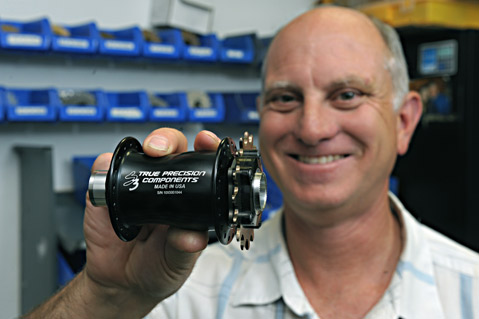True Precision Creates Winning Wheel Hubs
Goleta-Based Stealth Hubs Win Olympic Gold … and Silver

Todd Ackert did not spend four years training for the Olympics, he didn’t travel to London this past summer, and he may never get to wear an orbital hunk of precious metal around his neck. The owner and founder of Stealth Hubs can, however, credibly claim that he played a small but significant role in winning both the gold and silver BMX racing medals claimed by Latvian Maris Strombergs and Australian Sam Willoughby, respectively. They — and three more of the eight Olympic finalists — raced on hubs that Ackert designed and built in his Goleta machine shop.
The owner of True Precision Machining (trueprecisioncomponents.com), Ackert butters his bread by building components — such as ocean probes, light sources, camera parts, and instrument panels — for medical and aerospace companies like ATK, Raytheon, and Superconductor Technologies. Since 2000, however, he’s been quietly churning out some of the most trusted BMX and mountain bike wheel hubs in the industry.
Elite competitors stick with Stealth Hubs because of their revolutionary design. Most bicycle hubs — the center of the wheel and the part that spins — function on a pawl ratchet system. As the wheel spins, a spring-loaded arm (called a pawl) pushes down on the teeth of a gear at the hub’s center, creating the telltale clicking sound of the rotating freewheel on most bikes with multiple gears. The two shafts of Stealth Hubs, however, are enjoined by a clutch, which means there is no clicking. And if you are racing, it means that your competitors can’t hear you sneaking up on them.
The clutch system also provides instant engagement, meaning that the second your foot places a gentle breath’s worth of force on your pedal, the wheels start spinning, there being no play between two gear teeth. And although it might seem that such brute efficiency will only save riders a nanosecond, well, nanoseconds matter in a competitive setting.
Besides, the technology is just pretty freaking cool. To a greater extent than many other sports, cycling is a collaboration between man and machine. For many enthusiasts, part of the sport’s allure comes from the constantly advancing technology that converts muscle to speed. Lighter materials, stiffer tube sets, quicker shifting, aerodynamic wheels — just about any serious cyclist harbors an inner gadget geek.
Gadgets are expensive, though. Ackert charges about $500 for a pair of hubs, which can be anodized red, blue, or black. (He also made a special edition run of gold hubs to commemorate Strombergs’s Olympic victory.) Stealth only makes up about 10 percent of Ackert’s business. His 17 employees build the hubs themselves. With limited resources, he can’t exactly mass produce or market heavily, so he’s built up Stealth Hubs from the grassroots, running booths at BMX races and hawking them at the annual Interbike show — the industry’s largest convention — in Las Vegas. A chance encounter with Australian cyclist Wade Bootes while he was training in Santa Ynez led to a sponsorship of the Australian national team.
Ackert started building hubs during downtime at the shop at the suggestion of his employee Sean Calihan, a former BMX racer. And although Ackert hasn’t broken into big-time commercial success like Chris King — another South Coast machinist who started tinkering with bike components and is now famous for designing colorful headsets widely considered to set the standard — outfitting the world’s premier riders is not a bad source of validation. “It was neat,” he said recently, “to make something good enough that the world’s best want to run it.”



